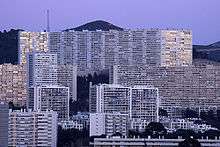Xavier Arsène-Henry
| Xavier Arsène-Henry | |
|---|---|
| Born |
10 May 1919 Bordeaux, Gironde, France |
| Died |
19 June 2009 Paris, Île-de-France, France |
| Occupation | Architect, urban planner |
Xavier Arsène-Henry (1919-2009) was a French modernist architect and urban planner. He designed many tall residential buildings on the outskirts of French cities.

Early life
Xavier Arsène-Henry was born on 10 May 1919 in Bordeaux, France.[1][2]
Career
He was a proponent of modern architecture.
In 1960, he designed a church, Église Saint Jean-Marie Vianney, located at 1 Place Mozart on the boulevard Président Wilson in Reims.[3] That same year, he designed three residential tall buildings in Reims: the Tour Berlioz, the Tour Bach, and the Tour Beethoven.[3] He designed similar residential tall buildings in Montereau-Fault-Yonne a year later, in 1961.[4][5]
He designed the Tour Chartis, also known as the Tour AIG, in Courbevoie in 1967.[6] A year later, in 1968, he designed the Centrale à béton in Ivry-sur-Seine.[7] That same year, he designed the masterplans of Bordeaux-Lac on the outskirts of his hometown of Bordeaux.[8]
He designed La Rouvière, a neighbourhood on the northern outskirts of Marseille, in 1969.[3] Four years later, in 1973, he designed the offices of the Corsican subsidiary of BNP Paribas at 475 Avenue du Prado in Marseille.[3]
He designed two buildings in Puteaux: Le Galion in 1982 and Le Minerve in 1984.[3]
He was a Professor at the École nationale supérieure des Beaux-Arts.[1] He was the recipient of the Rome Prize from the American Academy in Rome.[4]
Death
He died on 19 June 2009 in Paris.[2]
Bibliography
- La ville de l'an 2000 (revue Études, 1972).
- Notre ville, Mame, 1969
- Rentrons, il se fait tard, le long voyage d'un architecte (1919-1998) (Paris: L'Harmattan, 1999).
- J'allais oublier de vous dire... : suite du long voyage d'un architecte, 1998-2002 (Paris, L'Harmattan, 2002).
- Arrêtons nous quelques instants, 3e étape du long voyage d'un architecte (2002-2006) (Paris: L'Harmattan, 2006).
- Cap-Ferret : dessins et textes de Xavier Arsène-Henry : 50 ans de dessins (Elyte, 2008).
References
- 1 2 Xavier Arsène-Henry (1919-2009), Bibliothèque nationale de France
- 1 2 Xavier Arsène-Henry, Structurae
- 1 2 3 4 5 Architecte / Maître d'œuvre: Xavier Arsène-Henry
- 1 2 Florian Urban, Tower and Slab: Histories of Global Mass Housing, Routledge, 2013, p. 52
- ↑ Base Mérimée
- ↑ Structurae: Tour Chartis
- ↑ Structurae: Centrale à béton
- ↑ Bernard Gazeau, Cinquante ans pour créer un quartier, Sud-Ouest, 20 September 2009